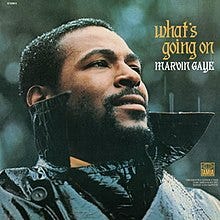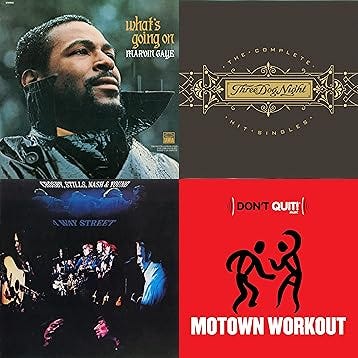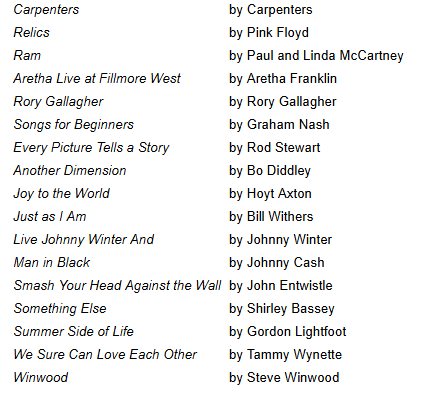In 1971, Marvin Gaye gave the world this beautiful album. The music and the vocals are uniformly amazing. And Gaye conveyed deeply held beliefs about what he was seeing wrong in the world along with some remedies.
As the Vietnam War raged on, like many Americans, Marvin Gaye experienced evolving political views. He was strongly affected by his brother Frankie’s recent return from his experience serving a three-year hitch in Vietnam. What’s Going On was the result of the process of Gaye’s reevaluation of his own views and the times his country was in. As an established hitmaker for Motown Gaye had to battle Berry Gordy about the direction of this album. In the end Gordy acquiesced that the times called for an album of strong political awareness.1 And that’s how we were gifted this gem. My rating:
In a 4-star retro review, The Chicago Tribune declared why this record was important. “Gaye was the first to break from the hit-factory assembly line. With What's Going On, he created soul music's first "art" album, an inner-city response to the Celtic mysticism of Van Morrison's Astral Weeks, the psychedelic pop of the Beatles' Sgt. Pepper's Lonely Hearts Club Band, the rewired blues of Bob Dylan's Highway 61 Revisited.”2
AllMusic deemed the album, “Marvin Gaye's masterwork, the most perfect expression of an artist's hope, anger, and concern ever recorded.” And, “the most important and passionate record to come out of soul music, delivered by one of its finest voices, a man finally free to speak his mind and so move from R&B sex symbol to true recording artist.”3
George Benson gave a remembrance of the album:
“It's a timeless record - Marvin's masterpiece. It helped that he could call on such a great team - they used to say you could record 'Mary Had a Little Lamb' at Motown and have a hit because the producers, arrangers and musicians there were so fabulous; people like James Jamerson, the bassist - these are the all-time greats. But Marvin co-wrote the songs and he was all over the record: dictating the way it should sound, whispering in the ear of the guitarist, telling him how to play something - maybe playing the drums himself. He made very tasteful use of the arrangements.
It was released in 1971 when I was living in Harlem, up on 125th Street by the Apollo Theatre. You'd hear it on the sidewalks or floating out of people's cars in the summer. My own career was in a good place, though I wasn't yet known beyond the jazz world. Shortly after the record came out I was in Detroit, driving back from the house of the owner of the club at which I was playing that night. I knew that Marvin's house was somewhere in the area, and suddenly I saw him, there in his yard, playing football with his children. It's the same yard as on the back cover of What's Going On.
I jumped out of the car and introduced myself, thinking he wouldn't know who I was. But he said he knew full well, and that he was coming to see me play that night. From that day on we were friends. Of course, his life was visited by tragedy but Marvin himself was never one to dwell on that.
He said to me one time: 'I didn't sing loud, I didn't sing hard on that record. I just tried to express myself. I just let it all hang out.' And when he sang, you knew that was the man himself you were hearing. Marvin Gaye wouldn't try and fake something, and he wouldn't only try and express an idea. Whatever he sang, it was completely him.”4
In 1001 Albums You Must Hear Before You Die, Bruno MacDonald wrote:
“Stricken by the death of his singing partner Tammi Terrell, increasingly ruled by drugs, and desperate to stretch the musical style for which he was famous - short and sweet soul songs - Gaye’s salvation lay in his humor and extraordinary talent. Both shine from an album that, in lesser hands, could have easily been a self-righteous drag.
“Words cannot do What’s Going On justice.”5
Enjoy and listen without prejudice. Cheers!
Prime Playlist: 255. What's Going On by Marvin Gaye
If you’re new here, welcome! Please consider subscribing and sharing with friends.
For details about this project, read this: Project 1001 Albums
Charts
• Peak on Billboard 200 album chart: #6 6
• Singles on Billboard Hot 100 chart: “What’s Going On”, #2; “Mercy, Mercy Me (The Ecology), #4; “Inner City Blues (Make Me Wanna Holler)”, #9 7
• RIAA certification: Gold | December 20, 19938
Released on May 21, 1971. Here’s what else was happening:
Pop Culture
• Number one song: “Joy to the World” by Three Dog Night9
• Number one album: 4 Way Street by Crosby, Stills, Nash & Young10
• Number one movie: Sweet Sweetback's Baadasssss Song by Melvin Van Peebles11
• Most watched TV programs: Mannix, Marcus Welby, Harlem Globetrotters, Adam-12, ABC Monday Movie, “Who’s Been Sleeping in My Bed?”, Hawaii Five-0”, All in the Family, Bold Ones, Ironside, Medical Center, Odd Couple12
• NYT bestseller, fiction: The Passions of the Mind by Irving Stone13
• NYT bestseller, non-fiction: The Greening of America by Charles Reich14
Some other albums released that month
Sport
• May 18 4th ABA Championship: Utah Stars beat Kentucky Colonels, 4 games to 3.
• May 18 Stanley Cup Final, Chicago Stadium, Montreal Canadiens beat Chicago Black Hawks for a 4-3 series victory.
• May 29 Indianapolis 500: Defending champion Al Unser Sr becomes first and only driver to win race on his birthday; leads for final 83 laps.16
Notable Births
• May 20 Tony Stewart, American race car driver.
• May 21 Eric Nies, American reality TV personality (MTV Real World, The Grind).
• May 26 Matt Stone, American actor, animator and producer (South Park, The Book of Mormon), born in Houston, Texas.17
Historical Events
• May 18 President Nixon issued a 112-page response to 60 demands made by the black members of the House of Representatives, rejecting some of their major proposals but saying he agreed with several others.
• May 21 National Guard mobilizes to quell riot in Chattanooga, Tennessee.
• May 30 36 hospitalized during Grateful Dead concert; drunk LSD apple juice.18
Notable Deaths
• May 19 Ogden Nash(1902-1971), American humorous poet (I'm a Stranger Here Myself, Masquerade Party), dies at 68.
• May 20 Martín Dihigo, Cuban Baseball HOF two-way player (2 × Negro League All-Star New York Cubans; 4 × Cuban League MVP), dies at 65.
• May 28 Audie Murphy, American soldier who was among the most decorated in WW II with 33 medals and actor (To Hell and Back, Whispering Smiths), killed in a plane crash at 46.19
Sullivan, Denise, Keep Pushing: Black Power Music From Blues to Hip-Hop, Lawrence Hill Books, 2011, p. 113-114.
MacDonald, Bruno, 1001 Albums You Must Hear Before You Die, Fifth printing, ed. by Robert Dimmery p. 224.
Ibid.
Ibid.






